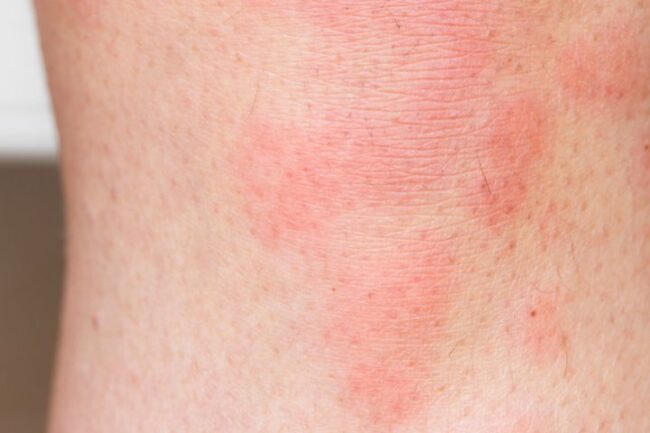While most modern varicose vein treatments are minimally invasive – ranging from a tiny incision for a laser fibre to sclerotherapy injections – they still sometimes require some form of tumescent anaesthetic. This can cause discomfort and for this reason, your doctor may provide further forms of anaesthesia for your comfort. Other factors influencing the type of anaesthesia in varicose vein treatment will depend on your doctor’s choice, their work facilities, whether the procedure is performed in addition to a phlebectomy (surgical removal of smaller veins), and your preference and pain threshold. In general, minimally invasive procedures DO NOT need to be performed under a general anaesthetic. Below is a summary highlighting the many types available:
Tumescent anaesthesia (Performed always as part of EVLA/RFA)
We use this anaesthetic type as part of Endovenous Laser Ablation and Radiofrequency Ablation procedures. We inject a very diluted form of local anaesthetic to make the procedure more comfortable. This local anaesthetic creates a ‘cuff’ around the vein, isolating it from surrounding tissues to ensure the laser heat stays within the vein walls. You will remain awake and alert, but should not feel pain. Most patients experience discomfort owing to the sting of the local anaesthetic. This part of the laser procedure is often considered the most uncomfortable. Hence, many doctors may use other forms of anaesthesia to help with the discomfort.
Outside of varicose vein treatment, this form of anaesthetic is also often used in cosmetic surgery. Often, this type of anaesthesia is used “off-label” in Australia. It is higher than TGA (Therapeutic Goods Administration) guidelines, but is still considered safe as the absorption is much less than non-dilute forms of the anaesthetic. The volume used is usually 300-500mls, including the dilute anaesthetic for each leg.
Risks of tumescent anaesthesia
You may experience some stinging or itching at the injection site. Numbness will generally fade in a couple of hours. Owing to its slow absorption rate, tumescent anaesthetic is safe and does not carry the dangerous side effects of general anaesthetic. Extremely rare is the possibility of an allergic reaction or toxicity from the local anaesthetic.
Nerve blocks
Regional Anaesthesia (Nerve block) is used to minimise pain during EVLA/RFA procedures, in particular the application of tumescent anaesthesia. Nerve blocks are generally considered easy and quick to perform and provide excellent pain relief.
As the procedures are walk-in and walk-out in some clinics, the nerves selected (usually the Saphenous Nerve in the Adductor Canal and Sural Nerve) will cover the majority of the treatment area when administering tumescent anaesthesia. However, it will not cover the whole area. Other more comprehensive nerve blocks may be available if the procedures are performed as a day procedure. These usually include Femoral Nerve Blocks and Sciatic Nerve Blocks. However, a small risk of temporary immobility can be associated with these blocks.
The nerve blocks we use last 4-6 hours and set in within 10 minutes. The are administered with a tiny needle under ultrasound guidance. Outside of vein treatment, nerve blocks are also used in childbirth (Cesareans and Epidurals) and knee surgeries.
Risks
Nerve blocks are safe and have few side effects and complications. Very rare complications include infection, dizziness, an allergic reaction or toxicity from the local anaesthetic being injected. In extremely rare circumstances, your muscle strength may be temporarily affected.
Topical anaesthesia
Some clinicians opt for topical anaesthesia (cream on the skin) such as EMLA cream or compounded agents. These creams will generally only help with the needling rather than the tumescent anaesthesia. However, they can be useful in many patients if correctly used. They are not considered as effective as other forms of anaesthesia, especially if they have not been applied for more than 30 minutes. Higher doses of compounded topical agents also pose a higher risk of anaesthetic toxicity.
Why we don’t use general anaesthesia

Minimally invasive varicose vein treatments don’t involve any large incisions, so tumescent or regional anaesthetics are sufficient. General anaesthesia also carries more side effects, including:
- Nausea and vomiting
- Sore throat
- Postoperative delirium (confusion when regaining consciousness)
- Muscle aches
- Itching
- Chills and shivering
It also carries some rare but serious risks and complications, including:
- Fever and muscle contractions
- Aspiration (when food or liquids are regurgitated into the airways during surgery)
- Delirium, which can last a few days to weeks
- Death, occurring from an overdose
Preparing for tumescent or regional anaesthesia
Unlike general anaesthesia, you won’t need specific preparation for local and regional anaesthetics. Simply follow the instructions provided by one of our doctors at the consultation. You may need to:
- Pause certain medications that thin the blood
- Stay hydrated by drinking 500 ml of water within a couple of hours of treatment
- Wear loose and comfortable clothing so we can wrap a compression bandage around your treated leg
Anaesthesia for varicose vein treatment: seek specialist advice
At The Vein Institute, we are committed to providing safe and high-quality care. Our specialists are trained to administer anaesthetic and treat varicose veins through minimally invasive methods. Should they recommend a treatment requiring tumescent or regional anaesthetic, they will go over the risks and benefits with you so you can be sure you’re making an informed decision.

